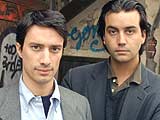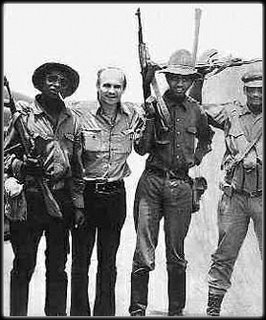The Muckraker in the Museum
 “BECAUSE THEY DIDN'T LOOK GERMAN” large letters spell out across the front of a building a mere fifty meters from the Brandenburg Gate. Below the sign are placards listing the victims of right-extremist violence in Germany, mainly foreign-born immigrants who were killed because, well, they didn’t look German. Dressing up the façade of the prominent Academy of the Arts [Akademie der Künste] with documentation of provincial bigotry alongside a major tourist landmark is, however, relatively toothless for artist Hans Haacke, the man behind the sign. As “Hans Haacke for Real: Works 1959-2006,” the exhibit inside documents, Haacke’s work often bites the hand that commissions it, turning upon museums and galleries as participants in morally questionable societal practices, and exposing the skeletons in the closet of those places that invite him to create art for them.
“BECAUSE THEY DIDN'T LOOK GERMAN” large letters spell out across the front of a building a mere fifty meters from the Brandenburg Gate. Below the sign are placards listing the victims of right-extremist violence in Germany, mainly foreign-born immigrants who were killed because, well, they didn’t look German. Dressing up the façade of the prominent Academy of the Arts [Akademie der Künste] with documentation of provincial bigotry alongside a major tourist landmark is, however, relatively toothless for artist Hans Haacke, the man behind the sign. As “Hans Haacke for Real: Works 1959-2006,” the exhibit inside documents, Haacke’s work often bites the hand that commissions it, turning upon museums and galleries as participants in morally questionable societal practices, and exposing the skeletons in the closet of those places that invite him to create art for them. For example, Haacke’s Manet-PROJEKT 74, created for the Wallraf-Richartz-Museum’s 1974 exhibition “PROJEKT 74,” chronicled the lives of the owners of the recently acquired Manet canvas Bunch of Asparagus. In so doing, it made public the Nazi-related past of Hermann J. Abs,
For example, Haacke’s Manet-PROJEKT 74, created for the Wallraf-Richartz-Museum’s 1974 exhibition “PROJEKT 74,” chronicled the lives of the owners of the recently acquired Manet canvas Bunch of Asparagus. In so doing, it made public the Nazi-related past of Hermann J. Abs,the driving force behind the canvas’ acquisition. It called to attention the widespread practice of “sweeping under the rug” of National Socialist past that occurred in the Federal Republic of Germany, a point only doubly proven when the museum declined to exhibit it.Haacke has also been censored when his works do not explicitly target the institution, such as in Shapolsky et al. Manhattan Real Estate Holdings, a Real Time Social System, as of May 1, 1971, which meticulously documents an implicitly immoral real estate practice through a series of photographs and charts. The “political” nature of the piece led to the Guggenheim’s refusal to include it in the show for which it was commissioned, creating one of the most famous cases of censorship of this century—at least until New York Mayor Rudolf Giuliani tried to strip the Brooklyn Museum of Art of its funding in 1999 for showing a painting he thought was offensive.
Because they didn’t look German presents a point upon which educated viewers will doubtlessly agree, as well as exposing reprehensible behavior of a non-white-collar sort that museum owners, trustees, boards, and the like, are not involved in or linked to and can safely condemn. (It also camouflages a building whose appearance Haacke recently likened to a “bank from the Seventies.") However, Haacke’s work needn’t have an implied “up-yours” to challenge the viewer: in many cases, the plethora of information calls upon the onlooker to piece it together. An appreciative glance is not enough to "get" the work, which often seeks above all not to be aesthetically "appreciated" but rather and above all understood.
Thus, the way Haacke’s work defines itself as art leaves a question mark hanging in the air. Those pieces composed of informational plaques or graphs, like Shapolsky, could just as easily be found in a sociological museum or a town-hall citizens gathering or college history class; they become “art” through their location in a museum or gallery. They defy clichéd notions about viewer subjectivity, since statements like “art is what you get out of it” or “beauty is in the eye of the beholder” don’t apply to Haacke’s works. Rather, each has a fairly specific point which cancels out other messages; for Shapolsky, is it obviously not correct to conclude that Haacke is praising Shapolsky’s business acumen.
 In fact, Haacke’s use of the phrase “Real Time System” is meant to indicate an art object that continues to function as depicted regardless of viewer perception or presence.[1] In Haacke’s early Conceptualist pieces, like 1965's Blue Sail, where a simple fan blows a blue sheet in the air, this functioning was mechanical. In later works like Shapolsky, it is sociopolitical. The choice to portray his message through the medium of art, then, when it is at times patently sociological and political, has been criticized by Slate editor Judith Shulevitz who encourages Haacke to stop “hiding out in an art museum” and join public discourse through the published journalistic word.
In fact, Haacke’s use of the phrase “Real Time System” is meant to indicate an art object that continues to function as depicted regardless of viewer perception or presence.[1] In Haacke’s early Conceptualist pieces, like 1965's Blue Sail, where a simple fan blows a blue sheet in the air, this functioning was mechanical. In later works like Shapolsky, it is sociopolitical. The choice to portray his message through the medium of art, then, when it is at times patently sociological and political, has been criticized by Slate editor Judith Shulevitz who encourages Haacke to stop “hiding out in an art museum” and join public discourse through the published journalistic word.However, the author of “Museums and the Consciousness Industry” knows what he is doing: he picks museums as his medium because he believes they are participants in cultural discourse to an equal degree as newspapers (or online culture rags).[2] Two of these “generators of consciousness” are exhibiting “Hans Haacke for Real” right now: the Academy of Arts here in Berlin until January 14th, and the Deichtorhallen Hamburg until February 4th, with the former focusing on works where politics and history play a central role, the latter on earlier works as well as works which address economic roles of corporations and museum sponsorship.
The Berlin exhibit, filling the downstairs gallery space at the AdK, is curated with an emphasis on dialog between the works, chronologically mixing them in order to create cross-decade correspondences. For example, Manet-PROJEKT 74 is shown alongside Der Bevölkerung, Haacke’s 1999 installation in the Reichstag, presumably since both address Germany’s sometimes selective and reluctant memory of its past. In the latter case disputed memory can be seen more prominently in the response to the work than the work itself: the parliamentary debate about whether or not to install it is shown here on video. Such supplementary explanations throughout the exhibit form a necessary backdrop to understanding Haacke’s work the way he would like; as he states, “When a work of this nature is shown outside its original context, background information needs to be provided so that the viewers can understand the references and the impact it might have had.”[3] The only drawback is that explanations of the work’s cultural relevance are all in German and no supplementary English materials are available, an ironic shame given the imperative to read and understand embedded in Haacke’s ouvre.
The last gallery features Haacke’s latest works, placing pieces critical of American jingoism, flag-waving, and attitudes towards Iraq, alongside his suggestion for a memorial to 9/11 and a smaller commemorative piece, the aptly titled Commemorating 9/11. Responding to a call from arts support group Creative Time for poster suggestions in October 2001, Haacke’s entry is simply a white outline of the World Trade Center’s two towers’ silhouettes, which is posted on top of previously existing billboard paste-ups such that the advertisement composes the body of the towers while white defines the space around them.The silhouette suggestion shows an almost insider’s sensitivity to what the loss means to New Yorkers once familiar with the sight of the World Trade Center.
 As seen in the annual re-creation of the buildings’ shape through the high-powered illumination of the Tribute in Light, the towers’ absence is a keenly visual loss to city inhabitants. The tragedy is not minimized but rather referenced with exquisite minimalism by these two projections of light into the sky. Haacke’s recreation of the silhouette even before the first showing of Tribute in Light—the visual memorial was first lit on March 11, 2002, six months after the attack—intuitively exhibits the same metonymy of visual loss for enormous societal loss, which makes sense since Haacke is a long-time resident of the city. (Perhaps unsurprisingly, Creative Time is also behind Tribute in Light).
As seen in the annual re-creation of the buildings’ shape through the high-powered illumination of the Tribute in Light, the towers’ absence is a keenly visual loss to city inhabitants. The tragedy is not minimized but rather referenced with exquisite minimalism by these two projections of light into the sky. Haacke’s recreation of the silhouette even before the first showing of Tribute in Light—the visual memorial was first lit on March 11, 2002, six months after the attack—intuitively exhibits the same metonymy of visual loss for enormous societal loss, which makes sense since Haacke is a long-time resident of the city. (Perhaps unsurprisingly, Creative Time is also behind Tribute in Light).Unfortunately I didn’t notice that these images of billboards contained a World Trade Center outline and had to read the wall text to put it together, assuming instead it was a commentary on pervasive visual culture in public space. If a native New Yorker equipped with the awareness of cultural context that Haacke describes as equally necessary to his process as “bronze or paint on a canvas,” doesn’t make the connection, then perhaps the need for explanation has gone too far.[4]The opposite problem was apparent with other new works, such as the enormous ripped American flag hanging from the ceiling, or the man wearing a flag-printed hangman’s hat-come-pillowcase that not only blocks his vision and obscures his individual identity but also threatens to smother him. Such simple social commentary seems a bit too obvious and uncomplex after the multivalent works in previous rooms.
Despite the weakness of the survey’s more recent offerings, it nonetheless presents a slice not just of the career of a thought-provoking artist but also snapshots of postwar Western society, through its descriptions of the work’s censorship or resultant political hullabaloo. Haacke’s work itself tries to prod the viewer into doing more than just “visiting a gallery” and the curators here ensure that the visitor sees not just a survey of painting but also of social criticism of the last several decades. And this relevance has no expiration date—with increased restrictions in American civil liberties as well as the growing Neo-Nazi movement in Germany, to name a couple examples, Haacke’s earlier work remains biting and important.
For more on the aesthetic happenings in Berlin, visit my blog A New Yorker in Berlin.
Exhibition catalog: Flügge, Matthias, and Robert Fleck, editors, Hans Haacke for Real: Works 1959-2006 Düsseldorf: Richter Verlag, 2006. (With contributions by Walter Grasskamp, Benjmain Buchloh, Rosalyn Deutsche.)
[1] Walter Grasskamp, Molly Nesbit, and John Bird, eds., Hans Haacke (New York: Phaidon, 2004), 41.
[2] First English publication: Ian North, ed. Art Museums and Big Business (Kingston: Art Museums Association of Australia, 1984), 33-40.
[3] Grasskamp., 12.
[4] Ibid., 12.







